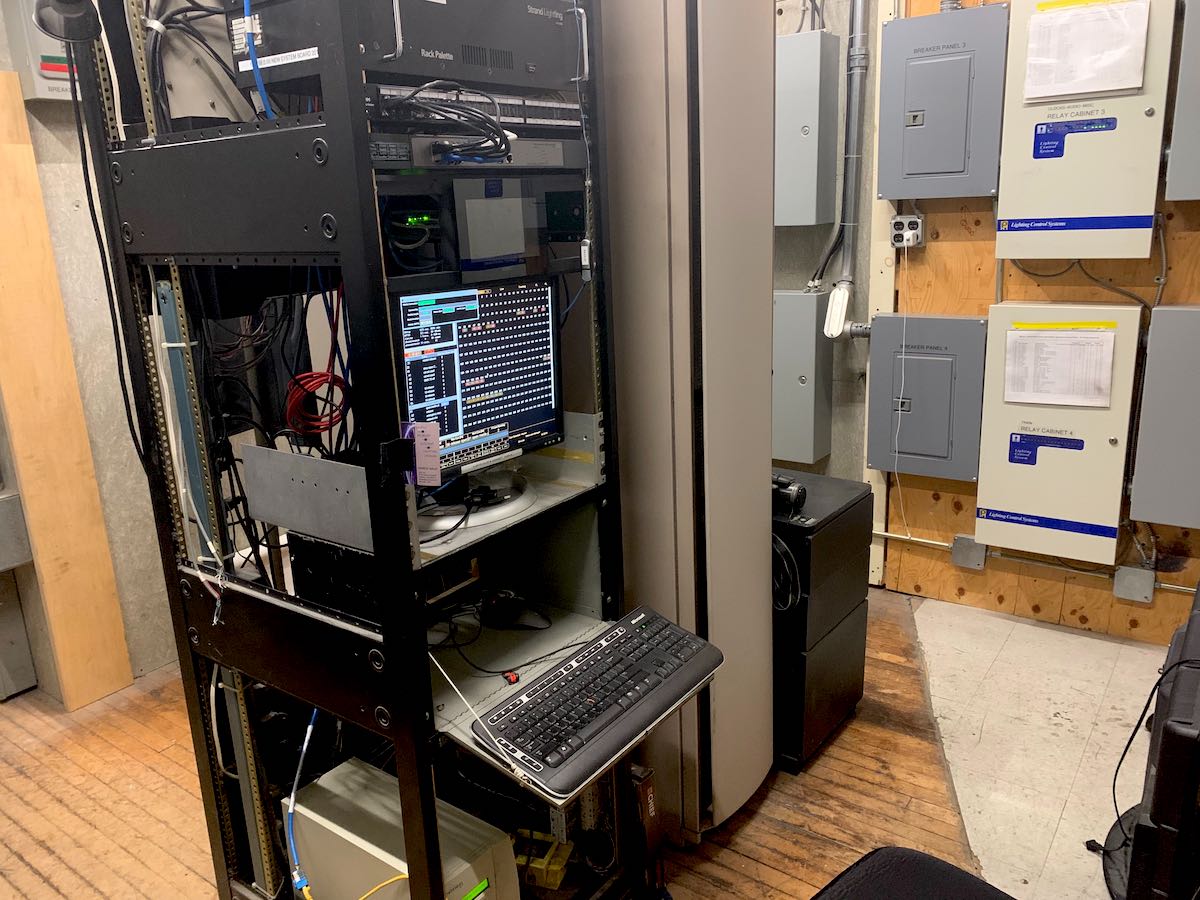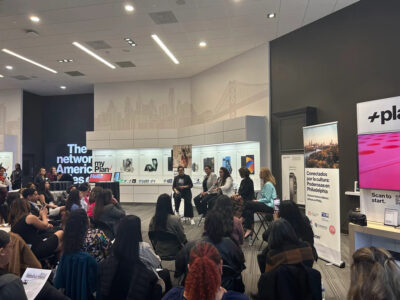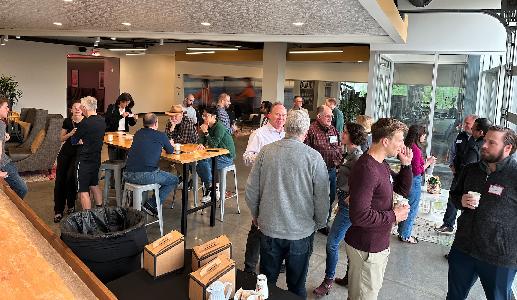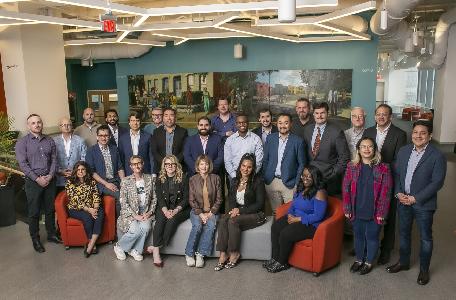The Tech Behind is a series in which we explore the technology that powers notable Philadelphia institutions. Have an idea for our next edition? Tell us.
For the thousands of visitors who come to Macy’s every day between Thanksgiving and New Year’s for its signature holiday light show, it might be easy to believe it all comes together with only a few sprinkles of Christmas magic.
That’s exactly how it’s supposed to appear, said Matthew Taft, Macy’s organ shop coordinator.
In reality, though, a crew of about 15 work overnight for nearly a week leading up to Halloween just to prepare. Folks from Macy’s Parade Studio come down to Philadelphia to oversee the construction of the show, and each light strand and circuit is tested before moving on to the next step.
First, panels of the holiday characters like the Nutcracker and Frosty the Snowman are rigged up, line by line. Then, the Christmas tree at the center of the show — which is about 50 feet tall — and 28 vertical custom-made strands of lights are added. The entire show takes up seven stories of the historic Wanamaker building, is more than 100 feet tall and uses about 100,000 lightbulbs.
Macy's uses 100,000 light bulbs to bring this show to life every year. pic.twitter.com/NvYssntVP6
— Paige Gross ✨ (@By_paigegross) December 11, 2019
“It’s super important to get things right as you go, or you’ll have to take it all apart to get to the problem,” Taft said.
When the Macy’s crew begins to pull the show decorations out of storage and begin construction again, they refer to notes from the previous year, Taft said, as they’re constantly learning the most efficient way to set up and tear down.
The crew have been able to use a lot of the materials from the show’s original debut in 1956. When Macy’s moved into the building in 2006, though, there were some updates. Much of the lighting was changed to more energy efficient LEDs, and the run-of-show program was automated. The store also added new circuits, dimmer racks, and a DMX universe — the lighting software that runs the show.

Behind the scenes in the tech closet, where the computer that runs the light show lives. (Photo by Paige Gross)
The display, of course, is integrated around the store’s Wanamaker Grand Court Organ, the world’s largest functioning organ which is played live during the noon and 6 p.m. finales of the light show. This is where Taft’s expert knowledge comes in, and he darts around the more-than-a-century old instrument to point out upgrades and technical advances that have been incorporated over the years.
In 2015, the organ got a technical update that changed its delay of sound from a few seconds to milliseconds, he said.

Organ Shop Coordinator Matthew Taft sitting at the Grand Court Organ on the third floor of Macy’s. (Photo by Paige Gross)
The show is currently programmed so that it begins automatically at 10 a.m., noon, 2 p.m., 4 p.m., 6 p.m. and 8 p.m. with prerecorded reminders every half-hour and five minutes before the show starts. During the 6 p.m. slot, lucky visitors hear the live organist play the finale of the 12-minute show.
While Taft said it’s impossible to know how many visitors are in the store each day for the light show, they do keep track of how many people come through Dickens Village on the third floor — and last weekend, it was about 16,000 people.
The store adds staff and extra security guards during this time of year, mainly to control crowds and make sure that shoppers or folks who need to get through can do so. Monday through Wednesday are the best days to come if you want to avoid huge crowds, Taft said, but once school’s out for the break, all order flies out of window.
After walking through storage areas and ducking into electrical closets, Taft leads me to what the staff call “Frosty Command Central” — the area on stage right of the tree and light display where the computer that run the show live.
From here, I can finally see how truly massive this bright, twinkling display is. As I’m marveling, Taft asks me if I’d like to climb inside the tree, and before I know it, I’m ducking between the biggest branches I’ve ever seen.
Climbing into the 50-foot tree at Macy’s with Matthew Taft, one of the store’s magic makers. pic.twitter.com/XxL9AYJFNF
— Paige Gross ✨ (@By_paigegross) December 11, 2019
It’s akin to the type of display at Rockefeller Center, and after hearing about all the hours of work that go into constructing this display, I get it. Taft and I wonder around on the platform for a little while, watching the crowd start to gather below us for the 4 p.m. show, when I finally ask: What’s it like to have a career making Christmas magic? Is it hard to keep the spirit alive when it’s your job?
“The crew is like a family and it’s a special connection you have when you work overnight, when you’re building Christmas,” he said. “But that’s just the kicking-off point. Watching the store translate and get the village together, it’s incredibly neat.”

A view of the store from where the tree is perched, on the third floor. (Photo by Paige Gross)
What keeps the magic alive, Taft said, is the connections that he makes with the city and other people in this role. Visitors are constantly telling him that the show is a deep part of their family traditions, and that they can’t wait to bring younger generations along to see it.
“I know I’m living a very bizarre life, when I realize that the first thought I have when I get up in the morning is about needing to take photos with Santa — that’s sort of a surreal thing,” he said. “Surrealism is your daily life.”
But it’s clear that Taft truly loves his job. While we head back to the organ to watch the show, we talk about the patterns of crowds throughout the day. Shopping and purchasing pretty much comes to a halt during the show, he said.
He’s saying this just as the lights dim, Christmas music swells, and Julie Andrews’ voice welcomes this round of show’s visitors. Just like Taft said, movement in the store below us slows and faces turn upward for the glowing, glittering display.
So I too, sit back and watch the show.
Join the conversation!
Find news, events, jobs and people who share your interests on Technical.ly's open community Slack

Philly daily roundup: A better coffee supply chain; Philly Tech Week returns; Apply to Pennovation Accelerator

Philly daily roundup: Startups want office culture; New Venture Lab cohort; Penn Med's new AI leader

Will the life sciences dethrone software as the king of technology?


